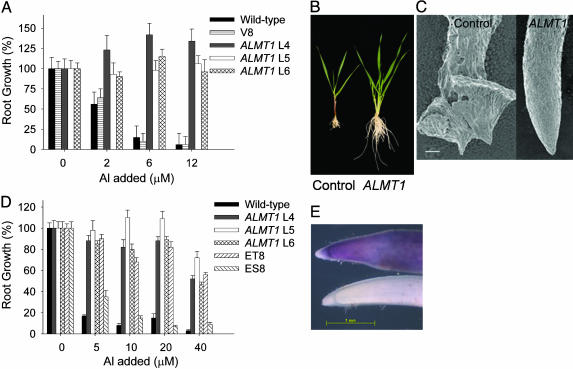Fig. 4.
ALMT1 confers Al tolerance to barley grown in hydroponic culture. (A) Root elongation of T0 (primary transgenics; lines 4-6 denoted by L4-L6) barley lines grown in hydroponic culture. Plants were grown for 10 days in nutrient solution that contained a range of Al concentrations. Control lines included WT and a transgenic line transformed with the vector only (V8). Elongation of the longest root over 5 days is expressed as a percentage of the minus-Al treatment, and error bars show ±SEM (n = 4). Root lengths of plants grown in the absence of Al were as follows: WT, 103 ± 14 mm; vector-only control, 103 ± 14 mm; ALMT1 line 4, 99 ± 12 mm; ALMT1 line 5, 122 ± 12 mm; and ALMT1 line 6, 118 ± 8 mm. (B) Effect of 3 μM Al on growth over 10 days of the T0 generation of the control (empty vector) line and ALMT1 line 5. (C) Scanning electron micrograph showing the effect of Al (3 μM) on the morphology of the root apex from the control line (empty vector) and ALMT1 line 5 grown for 10 days. (Scale bar, 100 μm.) (D) Root elongation of T2 homozygous barley lines grown in hydroponic culture. For each transgenic line, a sister line azygous for ALMT1 derived from the same transformation event was developed (lines 4-6 denoted by L4-L6). The wheat lines ET8 and ES8 are near-isogenic lines that differ in Al tolerance. Elongation of the longest root over 5 days is expressed as a percentage of the minus-Al treatment, and error bars show ±SEM (n = 7). Root lengths of plants grown in the absence of Al were as follows: WT, 54 ± 3 mm; ALMT1 line 4, 62 ± 4 mm; ALMT1 line 5, 46 ± 3 mm; ALMT1 line 6, 60 ± 4 mm; ET8, 66 ± 3 mm; and ES8, 74 ± 4. (E) Roots stained with hematoxylin. The bottom root is derived from the T2 homozygous ALMT1 line 5, and the top root is from its azygous sister line. Roots were exposed to 10 μM in nutrient solution for 24 h before being stained according to the procedures described in ref. 13. (Scale bar, 1 mm.)

